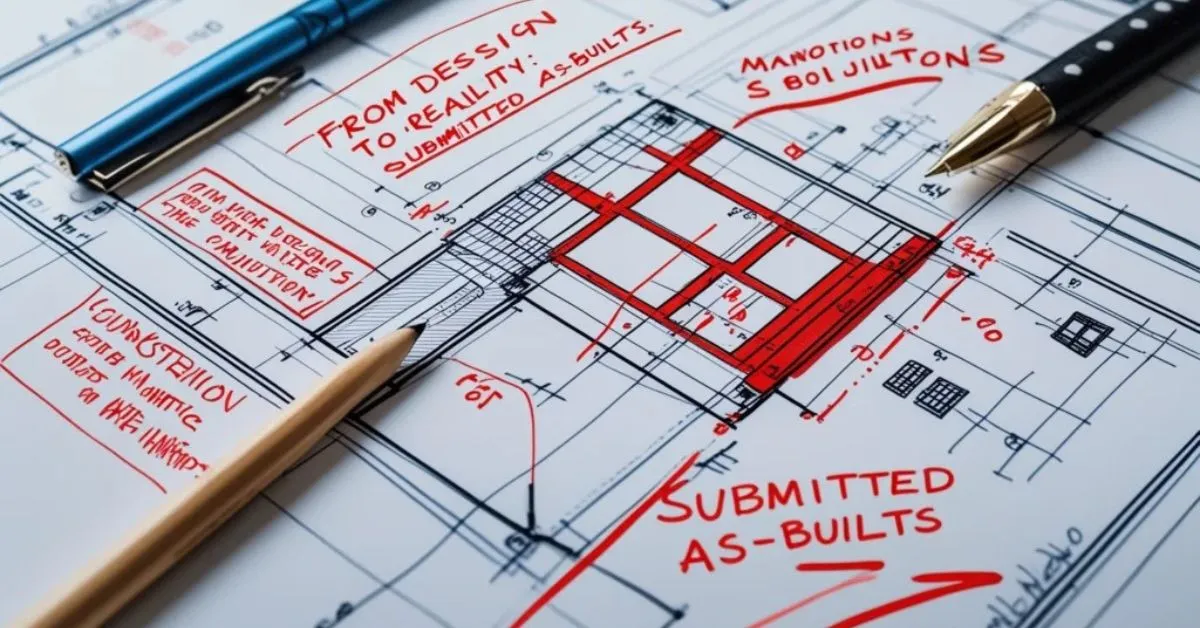What Are As-Built Drawings in Real Estate?
In the dynamic real estate and construction world, Submitted As-Builts in Real Estate—also known as record drawings or red-line drawings—are essential. These documents capture the project’s final state and enhance your design vocabulary by providing detailed insights into the construction process.
Submitted as-builts, a specific subset, are formal documents that reflect the actual construction as completed, differing from initial design plans. This article delves into the essence of submitted as-builts and their importance and answers essential questions related to their creation and use.
What Is Included in the As-Built Plan?
An as-built plan is a detailed document capturing:
Changes to Original Plans:
- Modifications to dimensions, materials, and locations of structural elements.
Final Dimensions:
- Accurate measurements of the completed project, including room sizes, window placements, and structural components.
System Installations:
- Detailed mapping of plumbing, electrical, HVAC, and other systems.
Construction Notes:
- Logs of changes made, reasons for those changes, and the dates they occurred.
Including these elements ensures that future stakeholders—whether contractors, engineers, or property owners—have a reliable reference point for maintenance, renovations, or compliance needs. This comprehensive documentation allows professionals to discover radial balance in design, ensuring that all elements are harmoniously integrated.
Who Submits As-Built Drawings?
The submission of as-built drawings typically involves multiple parties depending on the project’s scope:
Contractors:
- Primarily responsible for documenting on-site changes and submitting these revisions.
Architects and Designers:
- Often review and refine as-built submissions to ensure compliance with design standards.
Subcontractors:
- Provide detailed information about specific systems or components they installed, such as electrical or mechanical elements.
Collaborative efforts among these parties result in accurate, comprehensive as-builts that reflect the real-world outcome of a construction project.
What Should Be in an As-Built Document?
A complete as-built document should include:
Visual Representations:
- Floor plans, elevations, and cross-sections updated to reflect changes.
Annotations:
- Detailed notes explaining deviations from original plans.
System Details:
- Specifications for mechanical, electrical, and plumbing systems.
Material Logs:
- Types and quantities of materials used.
Photographic Evidence:
- Images showing key modifications and final installations.
Compliance Records:
- Notes on inspections and approvals.
This level of detail ensures as-built documents are functional for future use in property management, renovations, or resale.
What Is the Meaning of “As-Built”?
The term “as-built” refers to the actual condition of a construction project upon completion. Unlike initial design drawings that depict the intended construction, as-builts document the real-world implementation, accounting for:
- Unforeseen site conditions.
- Material substitutions.
- Design adjustments requested during construction.
In essence, as-builts provide a precise snapshot of a project as it stands after completion, making them indispensable for accurate documentation.
Whose Responsibility Is It to Create the As-Built BIM?
Building Information Modeling (BIM) enhances traditional as-builts by providing a digital, 3D representation of the completed project. Responsibility for creating an as-built BIM typically falls to:
General Contractors:
- They oversee construction and are well-positioned to document real-time changes.
Specialized BIM Technicians:
- Use advanced software to update digital models.
Architects:
- Collaborate to ensure the BIM aligns with the original design intent while capturing changes.
BIM technology streamlines the process, offering dynamic, interactive as-builts that are more accessible and detailed than static drawings.
Who Provides As-Built Drawings?
As-built drawings are often produced collaboratively:
Contractors:
- Supply field-marked changes directly observed during construction.
Subcontractors:
- Contribute detailed information on specific systems, such as HVAC or plumbing.
Architects and Designers:
- Integrate these changes into cohesive, final documents.
Ultimately, contractors are the primary providers, ensuring all modifications are captured accurately.
Who Is Responsible for the Production of Working Drawings?
Working drawings, which provide guidance for the construction process, are typically created by:
Architects:
- Develop detailed design plans.
Engineers:
- Add structural, mechanical, and electrical specifics.
Draftsmen:
- Translate designs into precise technical drawings.
While these documents precede construction, they evolve into as-built drawings through field updates and contractor input.
Who is typically responsible for creating shop drawings?
Shop drawings, distinct from as-builts, are detailed, component-specific plans created by:
Subcontractors:
- For specialized systems like HVAC or steelwork.
Fabricators:
- Document dimensions and assembly details for prefabricated components.
Suppliers:
- Provide manufacturer-specific installation guides.
These drawings are integral to the construction process, ensuring precise installation and alignment with overall design.
The Importance of Submitted As-Builts in Real Estate
Submitted as-builts hold immense value for various stakeholders:
Property Owners:
- Gain a clear understanding of their assets for future planning.
Contractors:
- Demonstrate professionalism and thoroughness, enhancing reputation.
Government Agencies:
- Use as-builts to verify compliance with building codes and regulations.
Future Contractors:
- Reference these documents to simplify renovations or additions.
Final Thoughts
Submitted as-builts in real estate are more than mere drawings; they are a comprehensive record of a project’s life cycle, reflecting its transformation from design to reality. By including accurate details, ensuring collaborative input, and leveraging modern as-built documentation techniques, these records become invaluable assets for property management, maintenance, and compliance.
Whether you are a contractor, property owner, or future developer, understanding the significance of as-built drawings in construction ensures a smoother, more informed approach to real estate management. Proper documentation also aids in regulatory compliance and future renovations, making as-builts essential for long-term property value.
For a comprehensive understanding of as-built drawings, including their importance, components, and best practices, check out this expert guide on as-built drawings.






